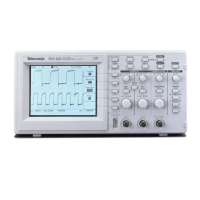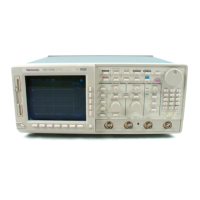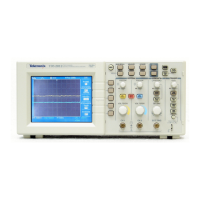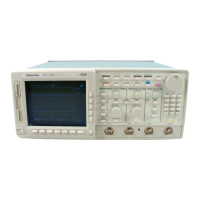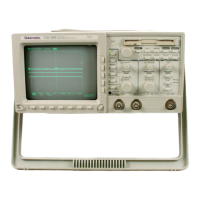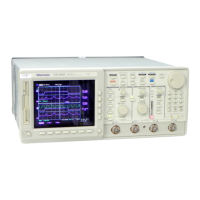Waveform Math
3–140
TDS 420A, TDS 430A, TDS 460A & TDS 510A User Manual
3. Press Set Function to
(side) repeatedly to cycle it to inv (invert), intg, or
diff. Waveform integration (intg) and waveform differentiation (diff) are part
of Option 2F.
4. To create the math waveform, press OK Create Math Wfm
(side).
To Use Dual Wfm Math
To create a math waveform that requires two waveform sources, do the
following steps:
NOTE. If you select the 120K record length in the Horizontal menu of a
TDS 400A, then you can only save one reference waveform. Also, you can only
use/display four waveforms. Even if you do not display the source waveforms,
Dual waveform math uses three of the four waveforms,. For example: if you
display a math waveform that is the sum of CH 1 and CH 2, even if CH 1 and
CH 2 are not displayed, you have used three waveforms. Therefore, you can only
display one additional waveform.
1. Press MORE
➞ Math1, Math2, or Math3 (main) ➞ Change Math
waveform definition
(side) ➞ Dual Wfm Math (main) (see Figure 3–78).
2. To define the first source waveform, press Set 1st Source to
(side) repeated-
ly to cycle it to the desired channel or reference waveform.
3. To define the second source waveform, press Set 2nd Source to
(side)
repeatedly to cycle it to the desired channel or reference waveform.
4. To enter the math operator, press Set operator to
(side) repeatedly to cycle it
through the choices. Supported operators are +, –, *, and on the TDS 510A /.
5. Press OK Create Math Wfm
(side) to perform the function.
NOTE. If you select *, for multiply, in step 4, the cursor feature measures
amplitude in the units volts squared VV rather than in volts V
.
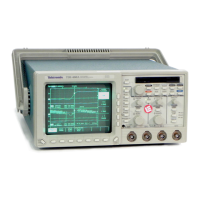
